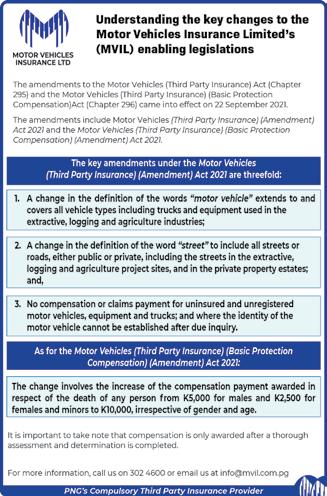
1 minute read
Kumul Petroleum moves to commercialise more fields
State-owned oil and gas company Kumul Petroleum has been gradually acquiring licences to some of PNG’s smaller and ‘stranded’ gas assets. Managing Director Wapu Sonk explains the strategy behind the move to BusinessAdvantagePNG
‘We welcome the different parties in Pasca A to come and talk to us, so we can present a combined position to either the PNG LNG project partners or TotalEnergies’ Papua LNG.’
Marketing its own product
Once it exercises its right to take up equity in the Papua LNG project, KPHL will eventually be free to market around 22 per cent of the project’s gas once the project loans are paid off. In the meantime, KPHL will continue to jointly market the gas with project lead,TotalEnergies.
The opportunities are significant, says Sonk.
In 2021, Kumul Petroleum was granted the Petroleum Retention Licence for the Pandora gas field in the Gulf of Papua. It followed the granting of three other licences – for the Kimu and Barikewa onshore gas fields in PNG’s Forelands region and offshore at Uramu earlier the same year.
All the fields have significant exploration histories. In the case of Pandora, estimated to contain one trillion cubic feet of gas, it has passed through several hands over the years.
‘The goal is to consolidate these isolated and economically challenging assets, previously held by different owners, and move toward commercialising fields,’ Wapu Sonk, Kumul Petroleum Holdings’ (KPHL) Managing Director, tells Business Advantage PNG
‘We will be looking to invite joint venture partners and technical service providers with the necessary technical and financial capabilities to assist in the development of these gas fields.’
Connecting stranded resources
Sonk wants to use KPHL’s unique position to aggressively develop these licences, while capitalising on synergies with PNG’s existing gas infrastructure.
In practice, this means ‘piecing together and connecting the resources that would otherwise be stranded into the existing facilities of the PNG LNG project, or what is going to be built by Papua LNG’s partners,’ he explains.
‘We see ourselves as the right partner in between all the parties to encourage aggregation and development.’
Given that it doesn’t really fit into that model, Sonk admits that a field like Twinza Oil’s Pasca A offshore field, close to Pandora, now remains a bit of an anomaly.
‘Pasca A alone doesn’t stack up,’ says Sonk. ‘They can strip the liquid condensate but the gas must go somewhere and the only place for the gas to go is into the PNG LNG or Papua LNG assets.
‘The market has started to open up. Beyond existing markets, there are secondary, tertiary markets developing,’ he observes.
‘There’s no destination process anymore in the local contracts, so LNG can go anywhere. It’s changed.’










